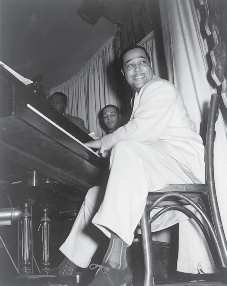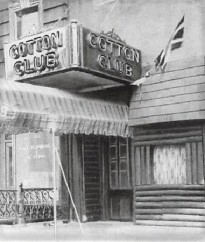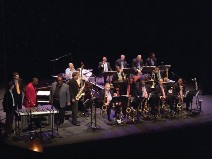13.4: 1965 - The Duke Ellington controversy
- Page ID
- 92085
\( \newcommand{\vecs}[1]{\overset { \scriptstyle \rightharpoonup} {\mathbf{#1}} } \)
\( \newcommand{\vecd}[1]{\overset{-\!-\!\rightharpoonup}{\vphantom{a}\smash {#1}}} \)
\( \newcommand{\id}{\mathrm{id}}\) \( \newcommand{\Span}{\mathrm{span}}\)
( \newcommand{\kernel}{\mathrm{null}\,}\) \( \newcommand{\range}{\mathrm{range}\,}\)
\( \newcommand{\RealPart}{\mathrm{Re}}\) \( \newcommand{\ImaginaryPart}{\mathrm{Im}}\)
\( \newcommand{\Argument}{\mathrm{Arg}}\) \( \newcommand{\norm}[1]{\| #1 \|}\)
\( \newcommand{\inner}[2]{\langle #1, #2 \rangle}\)
\( \newcommand{\Span}{\mathrm{span}}\)
\( \newcommand{\id}{\mathrm{id}}\)
\( \newcommand{\Span}{\mathrm{span}}\)
\( \newcommand{\kernel}{\mathrm{null}\,}\)
\( \newcommand{\range}{\mathrm{range}\,}\)
\( \newcommand{\RealPart}{\mathrm{Re}}\)
\( \newcommand{\ImaginaryPart}{\mathrm{Im}}\)
\( \newcommand{\Argument}{\mathrm{Arg}}\)
\( \newcommand{\norm}[1]{\| #1 \|}\)
\( \newcommand{\inner}[2]{\langle #1, #2 \rangle}\)
\( \newcommand{\Span}{\mathrm{span}}\) \( \newcommand{\AA}{\unicode[.8,0]{x212B}}\)
\( \newcommand{\vectorA}[1]{\vec{#1}} % arrow\)
\( \newcommand{\vectorAt}[1]{\vec{\text{#1}}} % arrow\)
\( \newcommand{\vectorB}[1]{\overset { \scriptstyle \rightharpoonup} {\mathbf{#1}} } \)
\( \newcommand{\vectorC}[1]{\textbf{#1}} \)
\( \newcommand{\vectorD}[1]{\overrightarrow{#1}} \)
\( \newcommand{\vectorDt}[1]{\overrightarrow{\text{#1}}} \)
\( \newcommand{\vectE}[1]{\overset{-\!-\!\rightharpoonup}{\vphantom{a}\smash{\mathbf {#1}}}} \)
\( \newcommand{\vecs}[1]{\overset { \scriptstyle \rightharpoonup} {\mathbf{#1}} } \)
\( \newcommand{\vecd}[1]{\overset{-\!-\!\rightharpoonup}{\vphantom{a}\smash {#1}}} \)
After Copland, the Pulitzer Prize was awarded to a long list of highly-educated white male composers writing in the European concert tradition. Clearly, jury members considered the production of “good music” to be linked to genre, race, and class. The winning works included symphonies, concertos, cantatas, and operas. However, the 1960s saw growing unease among listeners, performers, and scholars with this narrow definition of what could be “good” in music. Jazz, in particular, had developed into a sophisticated concert genre, and a number of composers were producing music that was, by many measures, just as “good” as
that coming out of the classical sphere. The primary differences lay in instrumentation (jazz band instead of orchestra), harmonic language (jazz composers used different scales and chords), and the incorporation of improvisation.

This tension came to the forefront in 1965. Upon considering the various nominated works, the Pulitzer jury concluded that none of them was worthy of the prize. Instead, they recommended that a special citation be granted to Duke Ellington (1899-1974) in recognition of his lifetime of accomplishment in the field of music. Ellington had initially been nominated by Viola Lomoe, the wife of a newspaper editor and a dedicated fan of jazz. She had suggested that the jury consider Ellington’s recent The Far East Suite, which she described as “being one of the larger forms of orchestral music” and therefore eligible for recognition. However, she also suggested that Ellington’s entire career was prize worthy. “If the whole body of Ellington work can be considered,” she wrote, “that can be heard anywhere, any time. In fact, it’s inescapable, though often it’s played or sung without a credit line.”
Ellington’s Career
Lomoe made a valid point about the ubiquity of Ellington’s music, which has become ingrained in American culture. He composed over 3,000 popular songs in his lifetime, the best-known of which is perhaps “It Don’t Mean a Thing (If It Ain’t Got That Swing)” (1931). Ellington first rose to national prominence as a pianist and band leader in 1927, when his group became the house band at the Cotton Club in Harlem. The Cotton Club was one of several 1920s-era establishments that catered to white New Yorkers who were attracted by the perceived danger and excitement of dabbling in African American culture. While the club only admitted white patrons, the musicians, dancers, and servers were all black. Patrons and employees were not permitted to mix, however, and the advertising and decorations established the Cotton Club as a place where white New Yorkers could safely encounter the exotic black other. Although Ellington and his musicians were sometimes required to play up to stereotypes, they were still able to create masterpieces in the jazz idiom, and their music was heard across the country via regular radio broadcasts.

For several decades after leaving the Cotton Club in 1931, Ellington and his band toured internationally and made popular recordings. Ellington always thought of his music as art, and he resisted the jazz label, instead describing his own creations as “beyond category.” While his songs gained the greatest popularity, many of his compositions relied on the extended forms of classical music.

The Far East Suite, recorded in 1966, is one such work. It contains nine movements, ranging from two-and-a-half to eleven-and-a-half minutes in length, and was inspired by world tours undertaken by Ellington’s group in 1963 and 1964. The suite was a collaboration between Ellington and Billy Strayhorn, his longtime creative partner. While cowriting is common in jazz, the fact that The Far East Suite had two composers sets it apart from the classical tradition, in which instrumental compositions are always the work of an individual.
Each selection on the album represents Ellington’s impressions upon visiting a foreign country. Commenting on the trip, Ellington stated, “The cats in the band go crazy about everything they see.” In essence, each piece took a geographic area as an artistic starting point, resulting in continuous contrast and the ongoing transformation of accompanimental ideas.
The Far East Suite
The Far East Suite includes an array of constantly evolving interactions between soloists (whether improvising or not) and unique combinations from within the ensemble.

A feature of Ellington’s compositions is the thoughtful use of each instrument’s unique voice. In the suite, each of the instrumental voices conjures up an element of the travel experience. The first movement of the suite, entitled “Tourist Point of View,”4 sets the mood by contrasting comforting and disorienting sounds. In the introduction, we hear dissonant chords played by the brass. Upon the entrance of the saxophone soloist, these are replaced by bright, high harmonies in the winds, which in turn give way to a call-and-response texture that pits the two sections against one another. The constant changes in texture and timbre suggest an onslaught of new and unfamiliar experiences. In the foreground, we hear smooth solos that use intervals similar to those in Eastern melodies, although the airy sound of the tenor saxophone serves as a touchstone of familiarity. The energy reaches a peak with Cat Anderson’s high trumpet playing, but the track concludes with a general decrescendo until finally the bass and drums fade out.
|
“Tourist Point of View” from The Far East Suite. Composer: Duke Ellington. Performance: Duke Ellington and his Famous Orchestra (1967) |
As the suite progresses, each movement takes on a new story, which is illustrated using a combination of unique musical elements. These range from the use of a clarinet in “Bluebird of Delhi” to portray the song of a bird, pitted against against a swinging ensemble (typical of Ellington/Strayhorn’s sound), to the muted brass improvisations in “Amad,” which suggest the Muslim call to prayer against a persistent piano ostinato.
“Isfahan”5 (a city in Iran) is captured with a slow jazz ballad that showcases the sound of Johnny Hodges on alto saxophone against a relaxed and relatively soft ensemble. This movement has an easygoing atmosphere. Dramatic harmonies, produced by winds and muted brass, are paired with heavy rhythmic punctuations and ostinatos. Gravity is provided by occasional full ensemble interjections, some of which are echoed by unaccompanied melodies in the saxophone. (“Isfahan” is still popular among jazz artists today and is regularly performed by ensembles of varying size).
|
“Isfahan” from The Far East Suite. 5. Composer: Duke Ellington. Performance: Duke Ellington and his Famous Orchestra (1967) |

We hear the influence of music from the 1960s in the rock inflections (especially in the drums) and non-swung beat divisions of “Blue Pepper.” But the suite quickly mellows in “Agra,” and concludes with what might be described as a sequence of cadenzas in the final movement, “Ad Lib on Nippon.” The Far East Suite took elements that had developed over the course of a decades-long collaboration between the artists Strayhorn and Ellington—in particular, the use of slowly- shifting ensemble colors that interacted with and influenced solo improvisations— to a new level, illustrating a story shaped by personal experience.
Disappointment
However, 1965 is not remembered as the first year in which a jazz composer was recognized with a Pulitzer Prize. This is because, despite the jury’s recommendation, the Pulitzer board refused to issue a special citation to Duke Ellington. Two jurors resigned in protest, and many more felt that a serious injustice had been perpetrated. The Pulitzer Prize was meant to recognize excellence in American music. Jazz was, without question, the most significant musical art form to have emerged in the United States, and Ellington was one of its most prominent and creative figures. If the purpose of the Pulitzer Prize was to celebrate excellence in American music, on what grounds was Ellington to be denied recognition? The man himself joked, “Fate is being kind to me. Fate doesn’t want me to be famous too young.” (He was 66 years old.) However, Ellington was offended—not because the board had rejected him, but because they had rejected a form of music that he valued highly. “Most Americans still take it for granted that European music—classical music, if you will—is the only really respectable kind,” he later said in an interview. “By and large, then as now, jazz was like the kind of man you wouldn’t want your daughter to associate with.” Ellington firmly believed that jazz could constitute “good music” and that criteria could be established by which the determine quality in jazz.
1997: WYNTON MARSALIS, BLOOD ON THE FIELDS
Despite the uproar, it was still to be several decades before a jazz composer would win the Pulitzer Prize for Music. By the 1990s, it was well established that the Pulitzer in music usually went to compositions for symphony orchestra. Occasionally, small chamber ensembles, choirs, and even solo piano were selected. Only once had the award gone to an electronic composition: Mario Davidovsky’s Synchronisms No. 6 for Piano and Electronic Sound (1970). It comes as no surprise that many musicians detected a sense of exclusiveness and prejudice on behalf of the Pulitzer committee.
In 1994, notable composer and performer Gunther Schuller (who had performed with jazz musicians Dizzy Gillepsie and John Lewis) was awarded the Pulitzer for his Of Reminiscences and Reflections, a composition for large orchestra. Although Schuller was a member of the jazz community, his winning composition contained few jazz elements. In particular, it lacked a jazz sound and performance style. As a result of his win, however, Schuller was invited to adjudicate for the 1997 Pulitzer in Music. The other jury members included a jazz critic, a jazz performer, and two traditional composers. With a majority of jury members having extensive experience in jazz, the panel finally chose to award the Pulitzer to a jazz musician.
Developing Blood on the Fields
Several years earlier, the Lincoln Center had commissioned jazz artist Wynton Marsalis (b. 1961) to present a new composition. The 32-year-old Marsalis was already well known as a jazz trumpeter and composer; indeed, he had established the Lincoln Center’s own summer jazz series in 1987, and had made great progress in his mission to institutionalize jazz as a respected American art form. Although Marsalis grew up in New Orleans and interacted with important jazz musicians from a young age, most of his early training was in classical music, and it was with the intent of pursuing an orchestral career that he enrolled in the Juilliard School in 1979. Although he soon decided that his future lay in jazz, Marsalis’s background prepared him to create music that drew from a diversity of traditions, styles, and forms. In response to the Lincoln Center commission, therefore, he decided to create a work in the European oratorio tradition. Oratorios employ an orchestra and vocal soloists to tell a story, although their presentation does not incorporate costumes, sets, or acting. Instead, the story is communicated entirely through sound.


For his oratorio, which was premiered in 1994, Marsalis crafted a narrative that related the experiences of an enslaved couple. His story begins on a slave ship and ends with the protagonists striking out for the north and freedom. The two main characters are Leona and Jesse, the latter of whom was a prince before his enslavement. Over the course of Blood on the Fields, the two aid each other in adjusting to their new lives, finding hope for the future, and eventually escaping from bondage. Originally, Marsalis had intended Blood on the Fields to be “tragic the whole way through, with no redemption.” Following extensive study and reflection, however, he concluded that optimism was “a very important part of the jazz expression.” Marsalis’s attitude—as well as his music—was deeply influenced by Duke Ellington, whose work he perceived as being essentially optimistic.
In creating the music for Blood on the Fields, Marsalis drew from a variety of African American traditions, including New Orleans jazz, blues, funk, chants, field hollers, work songs, and spirituals. He wrote for a jazz orchestra of forty musicians, with an important role for himself on the trumpet. In addition to playing their instruments, the orchestra members also recite text in unison to prepare each scene. Marsalis patterned this approach on the tradition of ancient Greek theater, which employed a chorus to narrate and reflect upon events.
Work Song (Blood on the Fields)
We will consider “Work Song (Blood on the Fields),”6 which is the sixth scene of the oratorio’s twenty-one. In this scene, Leona and Jesse are working in the fields, and they describe their monotonous labor and lament their unbearable situation. Although the scene follows quickly upon that in which they are purchased at auction, we are informed that in fact fourteen years have passed.
|
“Work Song (Blood on the Fields)” from Blood on the Fields. 6. Composer: Wynton Marsalis. Performance: The Lincoln Center Jazz Orchestra (1997) |
The first thing we hear is Marsalis’s trumpet. The growling sound he produces using a plunger mute is modelled on the playing of James “Bubber” Miley, who pioneered this style as a member of Ellington’s band in the 1920s. Marsalis’s improvisatory melody imitates the shapes and sounds of blues singing, although of course his playing communicates emotion without the benefit of words. In between his phrases, the members of the orchestra recite in unison.
Soon, the members of the orchestra establish a groove, which remains fairly consistent for the remainder of the scene. Throughout Blood on the Fields, Marsalis makes an effort to represent the motions and elements of each scene in music. In this case, we hear the regular rhythms of field labor. Punctuated brass exclamations and forceful drum hits emphasize the heaviness and effort of the work, while the unevenness of the rhythmic pattern suggests strain and sudden movements. The groove itself is rooted in the practices of various African and African-derived musical traditions. The process by which many distinct instruments each contribute a fragment to a complex musical whole is known as hocket, and is characteristic of black musical styles ranging from jali recitation to funk.
The regular interjections of other instruments suggest the sound and texture of New Orleans jazz, in which no single instrument carries the melody. Instead, each member of the ensemble contributes a distinct line to the texture, all of which combine to produce a rhythmic cacophony. In the case of “Work Song,” we might also hear the instruments as the voices of other enslaved workers, joining the two vocalists in protest.


